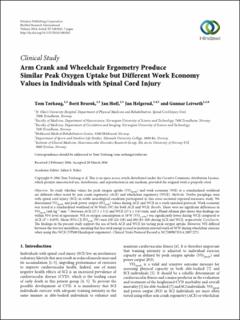Arm crank and wheelchair ergometry produce similar peak oxygen uptake but different work economy values in individuals with spinal cord injury
Peer reviewed, Journal article
Published version
Permanent lenke
https://hdl.handle.net/11250/2679510Utgivelsesdato
2016Metadata
Vis full innførselSamlinger
Originalversjon
Tørhaug, T., Brurok, B., Hoff, J., Helgerud, J., & Leivseth, G. (2016). Arm Crank and Wheelchair Ergometry Produce Similar Peak Oxygen Uptake but Different Work Economy Values in Individuals with Spinal Cord Injury. BioMed Research International, 2016, 5481843. https://doi.org/10.1155/2016/5481843Sammendrag
Objective. To study whether values for peak oxygen uptake (VO2peak) and work economy (WE) at a standardized workload are different when tested by arm crank ergometry (ACE) and wheelchair ergometry (WCE). Methods. Twelve paraplegic men with spinal cord injury (SCI) in stable neurological condition participated in this cross-sectional repeated-measures study. We determined VO2peak and peak power output (POpeak) values during ACE and WCE in a work-matched protocol. Work economy was tested at a standardized workload of 30Watts (W) for both ACE and WCE. Results. There were no significant differences in VO2peak (mL⋅kg−1 ⋅min−1) between ACE (27.3 ± 3.2) andWCE (27.4 ± 3.8) trials, and a Bland-Altman plot shows that findings are within 95% level of agreement. WE or oxygen consumption at 30W (VO2-30W) was significantly lower during WCE compared to ACE (𝑃�� < 0.039). Mean (95% CI) POpeak (W) were 130 (111–138) and 100 (83–110) during ACE andWCE, respectively. Conclusion. The findings in the present study support the use of both ACE and WCE for testing peak oxygen uptake. However, WE differed between the two testmodalities, meaning that less total energy is used to performexternal work of 30Wduring wheelchair exercise when using thisWCE (VP100 Handisport ergometer). Clinical Trials Protocol Record is NCT00987155/4.2007.2271.

